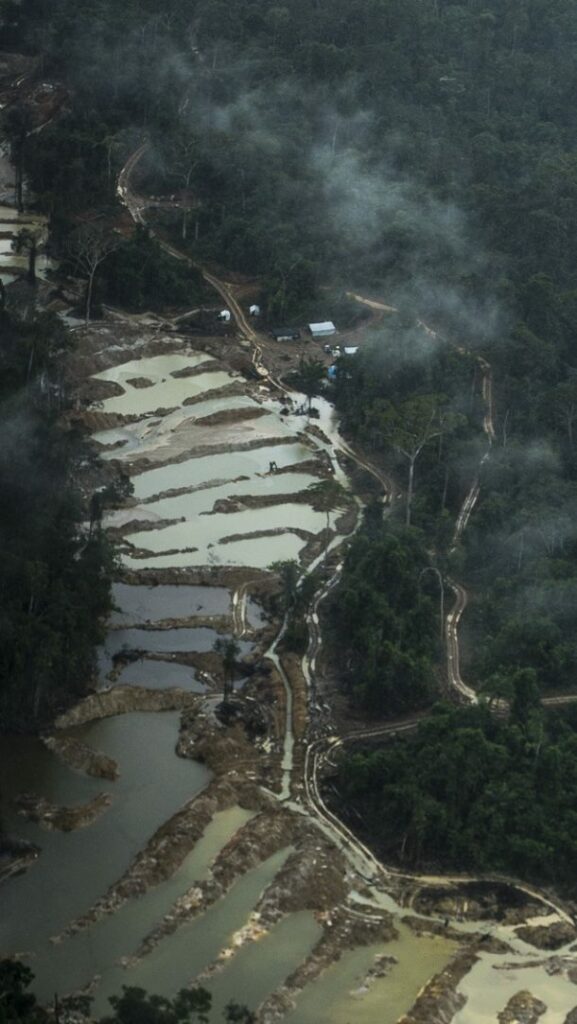Illegal Tin Mining Leaves Trail of Ruin in Protected Brazilian Rainforest
BRICS, ENVIRONMENT, 6 Jan 2020
Ana Ionova | Mongabay – TRANSCEND Media Service
-
- Floresta Nacional de Altamira (Flona de Altamira) spans some 724,965 hectares in the state of Pará, and is home to a rich diversity of plants and animals, including several species threatened with extinction.
- Recently, an influx of illegal mining has led to rampant deforestation and the sullying of rivers. The miners are targeting the mineral cassiterite, the main ore of tin. Illegal ranching and road construction are also causing deforestation in Flona de Altamira.
- The government intervened earlier this year to put a stop to the mining, but satellite imagery shows deforestation around mining sites has picked back up since October.
- Conservationists and activists worry the rhetoric and policy changes of the Bolsonaro administration are encouraging the invasions of Flona de Altamira and other protected areas that provide important refuges for Brazil’s wildlife and indigenous communities.
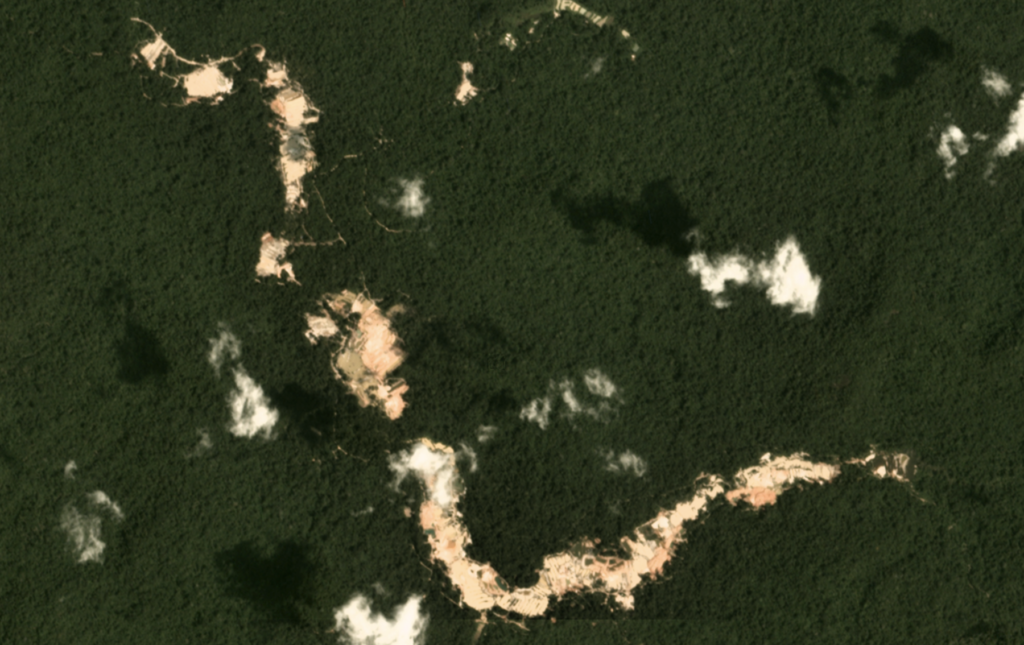
Satellite imagery shows extensive deforestation at the main cassiterite mining area in western Flona de Altamira. Multiple airstrips can also be seen. Image from Planet Labs.
30 Dec 2019 – The damage only became clear once the rain stopped and the clouds parted over Altamira National Forest in northern Brazil. Instead of dense jungle, large patches of bare land now flanked the banks of the rivers snaking through this protected stretch of the Amazon rainforest.
“When we got a clean satellite image, we just saw devastation,” said one source at a government environmental agency, who asked to remain anonymous because he was not authorized to speak on the matter. “We never saw anything like that in Altamira.”
Floresta Nacional de Altamira (Flona de Altamira) spans some 724,965 hectares in the northern state of Pará, with the bulk of the territory stretching across the municipality of Altamira. It is home to a rich diversity of plants and animals, including several species threatened with extinction such as the giant otter (Pteronura brasiliensis) and the Amazonian manatee (Trichechus inunguis).
The area was once a hallmark of sustainable forestry, in a region of the Brazilian Amazon where haphazard clearing and illegal deforestation are the norm. Under federal protection since 1998, Flona de Altamira holds a status that only allows regulated activities like licensed logging. Over the years, it became home to the largest area of forest concessions in the country. The goal was to boost the local economy, while minimizing the impact on biodiversity.
“It used to be our example of how things could work here, how we could create jobs, how we could use the Amazon rainforest in a sustainable way,” the government agent said. “And then everything fell apart.”
Escalating deforestation
Satellite data and imagery from the University of Maryland (UMD) show illegal deforestation has surged in Flona de Altamira over the past year, with local sources pointing to illegal mines, known as garimpos, as the key culprit in most of the protected area.
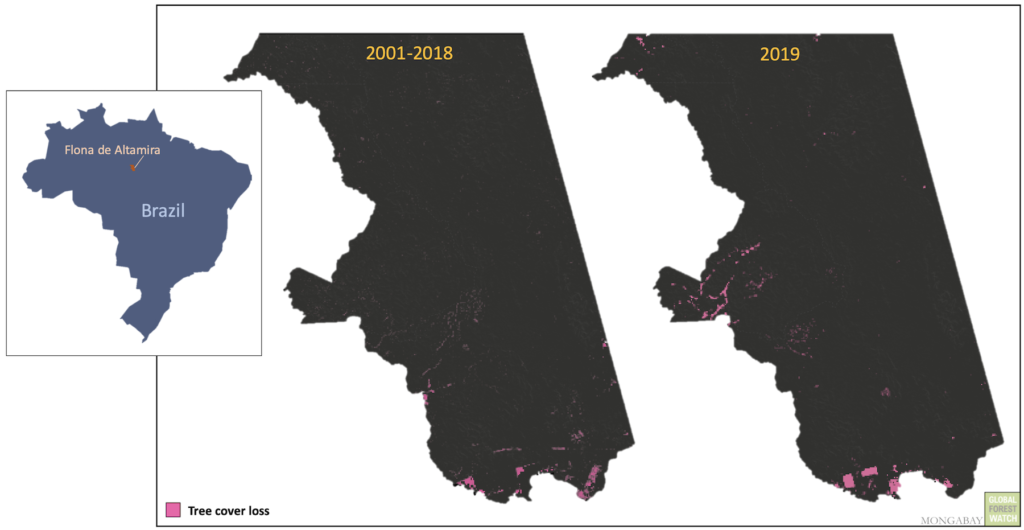
Satellite date from the University of Maryland indicate Flona de Altamira lost more tree cover in 2019 than during the previous 18 years combined. Mining is the major driver of deforestation in most of the protected area, with the exception of the southern portion where illegal clearing for ranching is intensifying.
Source: Hansen/UMD/Google/USGS/NASA, accessed through Global Forest Watch.
About 300 hectares were deforested between January and October 2019 just for mining, according to Thaise Rodrigues, a remote sensing specialist with Rede Xingu+, a network of environmental and indigenous groups working in the Xingu Basin.
This represents an increase of 85 percent over the prior year, Rede Xingu+ data show. Part of the pressure has come from a large clearing in its western frontier of the territory, “where a clandestine airstrip was built between May and June 2019,” Rodrigues noted.
Miners – or garimpeiros – often carve out makeshift airstrips deep in the Amazon, allowing supplies and equipment to be flown into densely forested areas by plane. Many also come with heavy machinery, including excavators, that can clear large chunks of forest easily.
Local sources say most of the miners invading Flona de Altamira are scouring for the mineral cassiterite, the main ore of tin. Gold miners, cattle ranchers and loggers in search of valuable tree varieties are also present in the area. Some of the invaders have also been carving out clandestine roads to help with the transport of minerals and timber out of the forest.
Authorities first detected the increase in mining activity in April, the government source said. But, faced with dwindling resources and a surge in forest clearing across the Amazon this year, federal agents only made their first raid on the area in late August. They destroyed some of the mining equipment and handed out fines – but, by that point, extensive and irreversible damage had already been done, according to the enforcement source.
Yet, following this initial crackdown, the forest clearing in Flona de Altamira resumed with force, with UMD data and imagery from Planet Labs showing a particularly dramatic increase in deforestation at several mining sites between October and November. This prompted authorities to go back twice more in November and December.
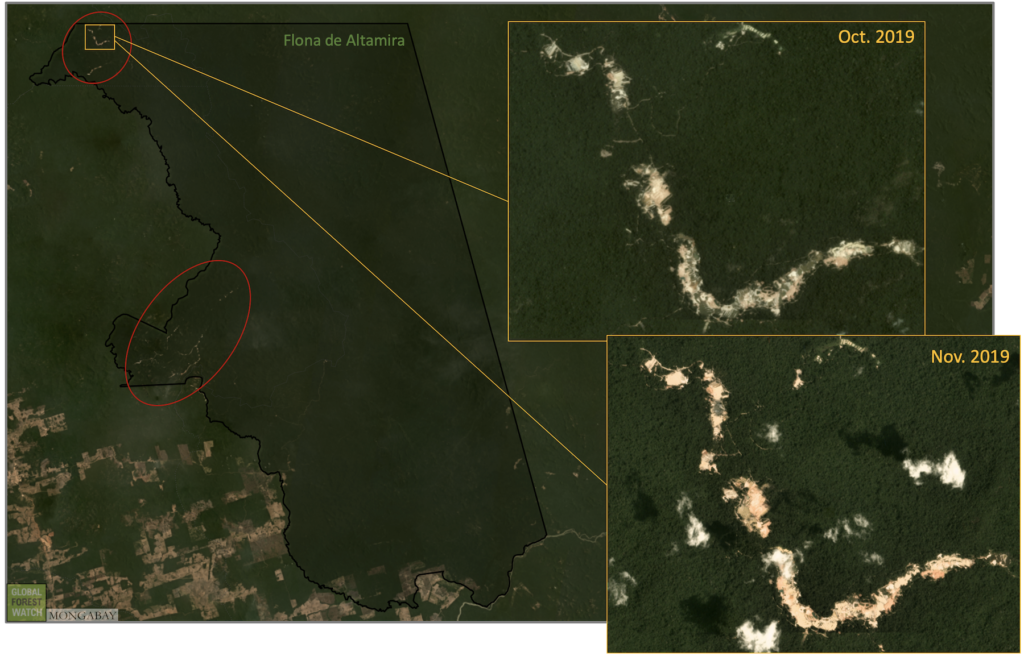
Flona de Altamira’s major sites of active mining (circled in red) show ongoing deforestation.
Imagery from Planet Labs accessed through Global Forest Watch.
“Now that we have a government that is way more hostile to the environment, the garimpeiros feel more powerful, they feel they can be successful,” said the enforcement source.
Mounting pressure
Like in much of Brazil, the mining fever gripping Flona de Altamira has its roots in the broader development of the Amazon region in the 1970s and 1980s. The construction of the BR-163, a behemoth highway stretching thousands of kilometers from the south of Brazil through the heart of the Amazon Basin, served as a catalyst: the eventual paving of the road in the 1990s brought a flood of people scouring the unexplored region for gold and other minerals.
“All of the deforestation started when we created a road,” said Antônio Victor Fonseca, an environmental engineer and researcher at Instituto do Homem e Meio Ambiente da Amazônia (Imazon). “So the government had this idea that we need to protect this area or we will lose all the forest here.”
The Flona de Altamira protected area was formed mostly to guard against such encroachment. The territory was also seen by Funai, the federal agency responsible for protecting the interests of indigenous people, as a crucial buffer for the neighboring Xipaya and Kuruayá indigenous lands.
But now, far-right president Jair Bolsonaro is sending much more encouraging signals to invaders – and local sources say this is emboldening illegal miners. The controversial new leader has been sharply critical of land protections, casting them as an “obstacle” to development and mining.
Bolsonaro – who has his own history of illegal mining in the Amazon – has also repeatedly vowed not to demarcate a centimeter of additional land for indigenous people. Currently, his administration is pushing forward a bill that would permit mining on indigenous land.
The president also supports reducing the boundaries of some protected areas and opening up the 4.6-million hectare Renca reserve to miners, a move that his predecessor Michel Temer abandoned following an international outcry and a federal court ruling.
“The interest in the Amazon isn’t in the Indian or the [expletive] tree – it’s in the mining,” Bolsonaro said in an impromptu speech to miners in October, referring to foreign investment interest.
This rhetoric has fueled the invasion of Flona de Altamira, which was already under mounting pressure from widespread clearing in the surrounding area, Fonseca said. Deforestation by miners, cattle ranchers and loggers has been particularly relentless in the Floresta Nacional do Jamanxim, which lies just southwest of it.
“We have a lot of pressure here,” said Fonseca. “This region is very, very critical because we already have a lot of deforestation around it.”
Meanwhile, rising tin prices gave a further incentive to miners this year, encouraging them to invade the mineral-rich Flona de Altamira. In March 2019, global tin prices hit their highest in more than a year, aided by a large expected deficit and rising demand for the metal, which is used in a variety of products ranging from cell phones to toothpaste. Tin prices have since fallen, with smaller spikes in September and December.
But unlike gold mining, extracting tin ore is less costly and difficult, making the activity particularly attractive to speculators, according to local sources. Illegal miners – many of whom are impoverished, illiterate men – have flocked to Flona de Altamira with the hopes of striking it rich.
Across the Brazilian Amazon, there are more than 450 illegal mines in the Brazilian Amazon, according to the Rede Amazónica de Información Socioambiental Georreferenciada (RAISG), a consortium of civil society organizations. Thousands of illegal miners toil away at these sites, extracting resources like tin, gold and nickel.
“They see the Amazon as this huge place that must be exploited, that must be invaded,” said Danicley Aguiar, a senior campaigner with Greenpeace Brazil. “It’s a predatory economic model.”
Losing the battle
Authorities have been trying to combat illegal mining in Flona de Altamira for years – but the recent spike in activity signals they may be losing the war.
As budgets at environmental agencies have been slashed in recent years, the state’s presence in the region has been dramatically weakened. Ibama, ICMBio and Funai have been forced to reduce staff and shut posts in remote parts of Brazil, leaving illegal miners free to invade protected territories without fear of being detected.
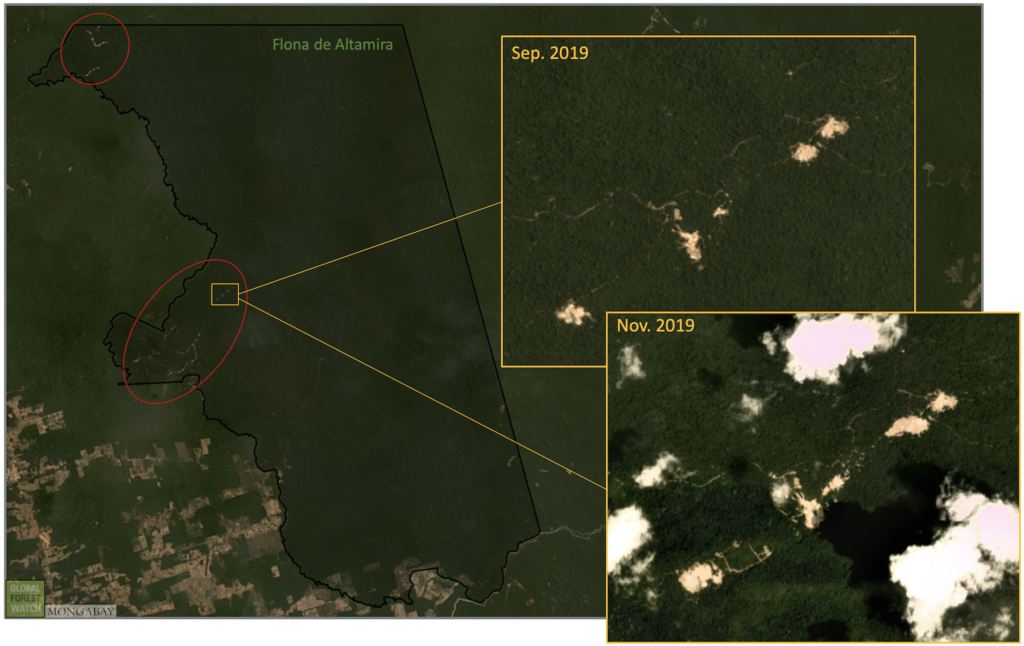
Satellite images show clearing activity moving away from the main mining site and further into Flona de Altamira. Imagery from Planet Labs accessed through Global Forest Watch.
Environmental enforcement – already undermined by prior administrations – has further deteriorated under Bolsonaro’s watch. Fines for environmental crimes have plummeted since he assumed office to their lowest in a decade, and earlier this year the president stripped Ibama, the country’s main environment agency, of some of its powers.
Recently, Bolsonaro sent a further positive signal to miners and loggers when he personally stepped in to stop Ibama from destroying machinery seized during a raid on a protected territory in Roraima.
In Flona de Altamira, the reduced state presence has had a tangible impact. Environmental agents raided the protected area multiple times in 2016 and 2017, doling out fines and destroying equipment, sources said. Yet authorities stepped back from the area entirely in 2018 and returned this year only to find mining activity had surged back with renewed force.
Meanwhile, illegal miners have become bolder, as the Bolsonaro administration has signaled it may be on their side. In late October, they blocked several key highways in Pará and demanded that the government legalize their activity and stop enforcement agents from damaging mining equipment.
“When this type of rhetoric is put on the table, it’s only natural that garimpeiros will feel supported by the government in their activity,” Aguiar said. “It creates an expectation.”
Lost forests, polluted rivers
In recent months, Flona de Altamira has also seen a surge of deforestation driven by clandestine road-building and illegal agricultural development, as cattle ranchers convert more forest to pastures.
By comparison, mining generally accounts for far less forest destruction – but it can leave a profound imprint on ecosystems and water resources. In Flona de Altamira, local sources point to the surge in mining activity as a key contributor to the stark deterioration in the water quality of Rio Aruri.
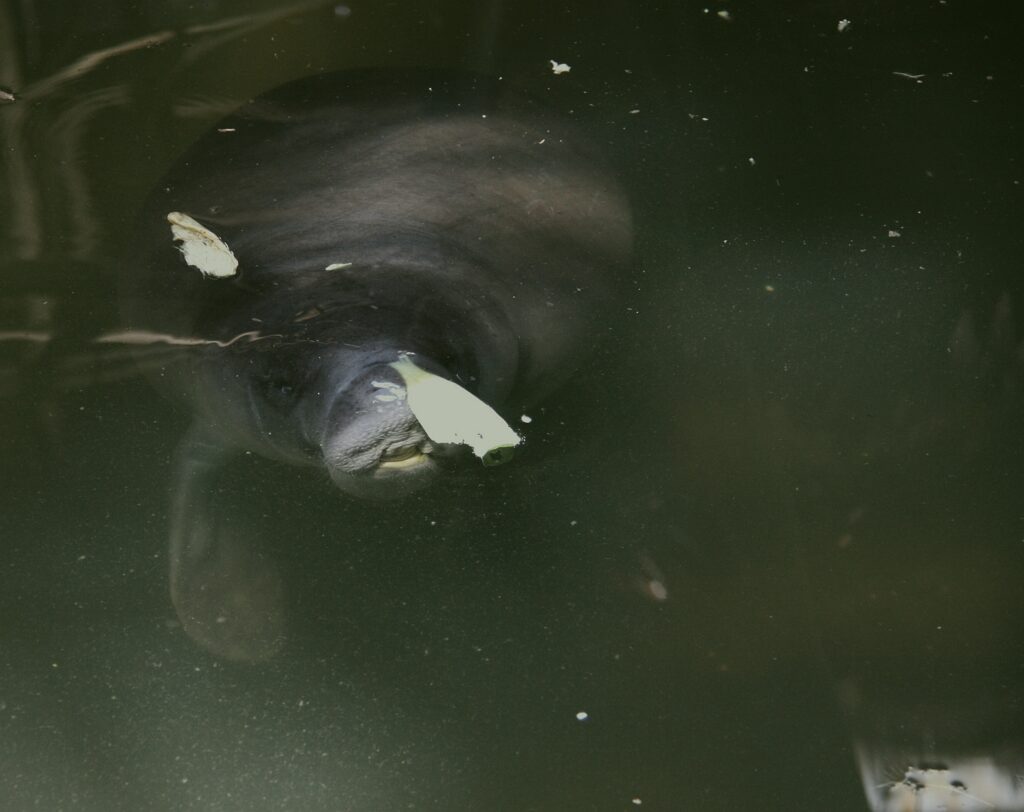
Amazonian manatees live in Flona de Altamira and are threatened with extinction. Photo by Dirk Meyer via Wikimedia Commons (CC BY-SA 4.0).
While some tin ore can be found in ground rock, most easily accessible deposits are concentrated in streams and along river banks. When forest and topsoil are removed from shorelines for mineral extraction, soil and mining waste run unobstructed directly into the river when it rains.
Tin ore mines also use water from nearby rivers for hydraulic extraction and then dispose of the waste in mining ponds and tailings dams nearby. Research has linked highly toxic tin ore waste stored in tailings dams to dramatic pollution of soil, vegetation, surface water and groundwater.
In the case of gold mining, where mercury is often used in the extraction process, the impact on human and animal health can be devastating. Studies have linked exposure to the element to skin disease, infertility and birth defects. Mercury can also contaminate fish populations, travelling vast distances and amplifying in toxicity up the food chain.
The pollution entering Rio Aruri then flows further afield, contaminating other regions and communities. Notably, Rio Ariri connects with the larger Rio Jamanxim, an important river that winds through several protected areas, including Floresta Naciona de Itaituba and the Área de Proteção Ambiental do Jamanxim. A few kilometres upstream, Rio Jamanxim also flows into Rio Tapajós – a major tributary of the Amazon River.
Activists in the region also worry about the impact on neighboring protected areas, such as the Xipaya, Kuruayá and Bau indigenous territories. Across the Brazilian Amazon, some 18 indigenous territories have already been invaded by illegal miners, according to RAISG. “There’s huge pressure on indigenous lands from mining,” Aguiar said.
The region around Flona de Altamira is also home to river-dwelling and other traditional communities whose members harvest Brazil nuts within the forest. These communities often rely on the local rivers to fish and sustain their traditional lifestyles.
Conservationists and activists working in the area say the invasion of the region – and the pollution of the area’s water sources – can have detrimental impacts on the health and livelihoods of those dependent on the forest for survival.
“The problem is, when you contaminate the water, the impacts travel,” Aguiar said. “A mine has the power to impact thousands of people – it can affect generations.”
__________________________________________________
Editor’s note: This story was powered by Places to Watch, a Global Forest Watch (GFW) initiative designed to quickly identify concerning forest loss around the world and catalyze further investigation of these areas. Places to Watch draws on a combination of near-real-time satellite data, automated algorithms and field intelligence to identify new areas on a monthly basis. In partnership with Mongabay, GFW is supporting data-driven journalism by providing data and maps generated by Places to Watch. Mongabay maintains complete editorial independence over the stories reported using this data.
 Ana Ionova is a freelance multimedia journalist covering the environment, human rights and politics in Brazil. Her work has been published by Reuters, The New York Times, Foreign Policy, Al Jazeera and others. She has previously worked in Argentina, the Balkans and the Middle East.
Ana Ionova is a freelance multimedia journalist covering the environment, human rights and politics in Brazil. Her work has been published by Reuters, The New York Times, Foreign Policy, Al Jazeera and others. She has previously worked in Argentina, the Balkans and the Middle East.
Go to Original – news.mongabay.com
Tags: Amazonia, BRICS, Bolsonaro, Brazil, Cattle and Ranch Farmers, Climate Change, Corruption, Deforestation, Environment, Forest fires, Global warming, Indigenous Rights, Latin America Caribbean, Meat Industry, Nature's Rights, Rain Forests, Resources, Tin Mining, Violent conflict
DISCLAIMER: The statements, views and opinions expressed in pieces republished here are solely those of the authors and do not necessarily represent those of TMS. In accordance with title 17 U.S.C. section 107, this material is distributed without profit to those who have expressed a prior interest in receiving the included information for research and educational purposes. TMS has no affiliation whatsoever with the originator of this article nor is TMS endorsed or sponsored by the originator. “GO TO ORIGINAL” links are provided as a convenience to our readers and allow for verification of authenticity. However, as originating pages are often updated by their originating host sites, the versions posted may not match the versions our readers view when clicking the “GO TO ORIGINAL” links. This site contains copyrighted material the use of which has not always been specifically authorized by the copyright owner. We are making such material available in our efforts to advance understanding of environmental, political, human rights, economic, democracy, scientific, and social justice issues, etc. We believe this constitutes a ‘fair use’ of any such copyrighted material as provided for in section 107 of the US Copyright Law. In accordance with Title 17 U.S.C. Section 107, the material on this site is distributed without profit to those who have expressed a prior interest in receiving the included information for research and educational purposes. For more information go to: http://www.law.cornell.edu/uscode/17/107.shtml. If you wish to use copyrighted material from this site for purposes of your own that go beyond ‘fair use’, you must obtain permission from the copyright owner.
Read more
Click here to go to the current weekly digest or pick another article:
BRICS:
- The “BRICS Sovereigns” vs the “Globalist Oligarchy”
- Cuba Joining BRICS Is a Lifeboat for Its Economy
- BRICS and G20 Value Platforms: A Comparative Analysis
ENVIRONMENT:
